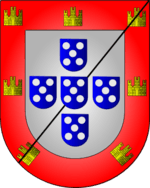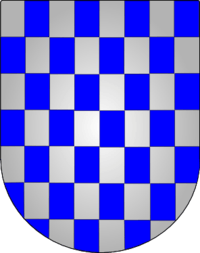Duke of Abrantes
Duke of Abrantes (Portuguese: Duque de Abrantes) is a noble title that was created separately in the peerages of Spain, Portugal and France. The Spanish title is the only one of the three that is still extant. The three dukedoms are unrelated, but they all took their name from the city of Abrantes (Portuguese pronunciation: [ɐˈbɾɐ̃tɨʃ]), situated in the province of Ribatejo in Portugal.

1642 - The Dukes of Abrantes (Spanish title)

The title of Duke of Abrantes (Spanish: Duque de Abrantes) is a Spanish title that was created by King Philip IV of Spain on 23 March 1642 in favour of Portuguese nobleman Afonso of Lancaster, Marquis of Porto Seguro. Afonso of Lancaster was the second son of Álvaro, 3rd Duke of Aveiro, and he received this ducal title as a reward for supporting the Spanish Crown.
Bernardo de Carvajal y Moctezuma, 2nd Count of Enjarada, is an ancestor of the Dukes of Abrantes, thereby making them descendants of Doña Isabel Moctezuma and the Aztec Emperor Moctezuma II. This ducal family formerly owned the Palacio de los Toledo-Moctezuma at Cáceres in Spain.
The Habsburgs were deposed from the Portuguese throne in 1640, two years before this dukedom was created. The title was never recognised in Portugal, but it remains extant in Spain. The present Duke of Abrantes, who is also a Grandee of Spain, is Don José Manuel de Zuleta y Alejandro.[1][2][3]
- Buildings
- Recreo de las Cadenas
- Palacio del Marqués de Casa Riera
1753 - The Duchesses of Abrantes (Portuguese title)

The title of Duchess of Abrantes, unrelated to the Spanish and French titles, is the only one that was officially recognised by the Kingdom of Portugal. It was created by decree of King Joseph I of Portugal, on 9 December 1753, for Ana Maria Catarina Henriqueta de Lorena, 3rd Marchioness of Abrantes and 9th Countess of Penaguião.[4]
The King advanced Dona Ana Maria de Lorena, 3rd Marchioness of Abrantes, to the rank of duchess (vitalício) upon her appointment as The Queen's Maid of Honour (Camareira-Môr), the highest court position for ladies. The title was subsequently revived for the same reason in favour of her daughter Maria Margarida, considered to be the "2nd Duchess".
List of the Duchesses of Abrantes
- Ana Maria Catarina Henriqueta de Lorena, Duchess of Abrantes vitalício (1691–1761), also 3rd Marchioness of Abrantes;
- Maria Margarida de Lorena, Duchess of Abrantes vitalício (1713–1780), also 4th Marchioness of Abrantes (daughter of Duquesa Ana Maria).
Subsidiary titles held by the Duchesses of Abrantes
- Countess of Penaguião, created in 1583 by King Philip I of Portugal;
- Marchioness of Abrantes, created in 1718 by King John V of Portugal.
1808 - The Dukes of Abrantès (French title)
.svg.png)
After the King of Portugal's refusal to join the Continental Blockade, Napoleon I despatched General Jean-Andoche Junot in command of the French invasion of Portugal. General Junot marched through Portugal and set up camp at the city of Abrantes, before advancing on Lisbon.
After the French victory, Napoleon conferred the victory title of Duke of Abrantès (French: Duc d'Abrantès) upon General Junot. His wife was the French writer Laure née Martin de Permont, and she became styled as the Duchess of Abrantès.
This dukedom, extinct since 1982 upon the death of Maurice, 6th Duke of Abrantès, was never formally recognized by the Portuguese government.
See also
- Count of Abrantes
- Genealogical tree of the House of Abrantes
- House of Abrantes
- House of Lancaster
- List of Portuguese Dukedoms
- Marquis of Abrantes
References
- "José Manuel Zuleta y Alejandro, duque de Abrantes". Official website of the Royal Household of His Majesty the King of Spain. Archived from the original on 17 October 2015. Retrieved 17 October 2015.
- "José Manuel Zuleta y Alejandro" (PDF). Boletín Oficial del Estado (in Spanish). Page 49262. Retrieved October 17, 2015.
- www.elmundo.es
- "Duques de Abrantes - Geneall.net (Portuguese)". Geneall.net.
Bibliography
- Nobreza de Portugal e do Brasil, Vol. II, pp. 203–208, Lisbon, Zairol, 1989.